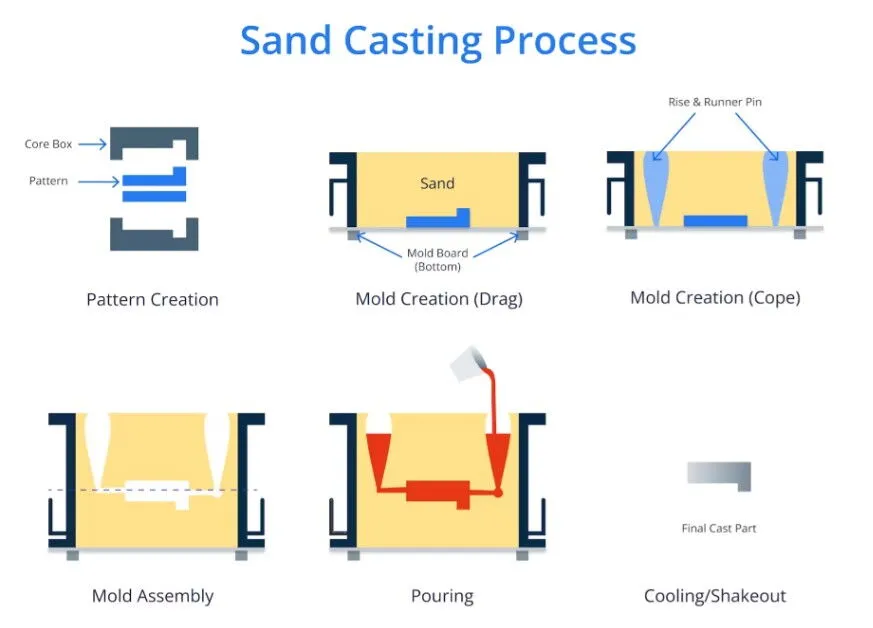Sand casting is a traditional casting method that uses sand as the primary material to create molds. It is one of the oldest and most widely used casting techniques. Due to its unique advantages, such as the ability to accommodate parts of various shapes, sizes, complexities, and alloy types, sand casting is extensively employed in the production of single-piece and small-batch castings. It is characterized by low cost, short production cycles, and ease of operation, making it particularly suitable for mass production and complex-shaped castings.
The sand casting process can be divided into several key steps: sand preparation, pattern making, molding, pouring, cooling, shakeout, cleaning, and inspection. Each step is crucial and directly impacts the quality of the castings and production efficiency.

Sand preparation is the first step in sand casting, aimed at preparing molding sand and core sand. Typically, a sand mixer is used to blend old sand with an appropriate amount of clay, creating a suitable sand material for casting. The quality of the prepared sand significantly affects the strength of the mold and the surface quality of the castings.
Based on the part drawings, appropriate materials and techniques are selected to create the casting pattern. For single-piece castings, wooden patterns are often used, while for batch production, plastic or metal patterns (such as iron or steel patterns) are typically employed. The pattern's dimensions are slightly larger than the final product's dimensions, with the difference known as the shrinkage allowance. This compensates for the metal's volume reduction during cooling and solidification.
Molding involves shaping the external cavity of the casting using molding sand, while core making forms the internal shapes of the casting. Core making is a critical step in sand casting, especially for castings with complex internal structures. Precise core preparation is essential to ensure the casting's accuracy. The core is placed into the mold, and the upper and lower sand molds are assembled to form a complete casting mold.
During the pouring stage, molten metal is injected into the prepared mold through the gating system. The pouring speed must be carefully controlled to ensure the metal fills the mold cavity evenly and to prevent defects such as bubbles and cracks. To counteract thermal shrinkage, the gating system provides additional metal supply, ensuring complete solidification of the casting.
Once the molten metal fills the mold and solidifies, the casting takes its initial shape. The cooling time depends on the casting's size and the type of metal used. After cooling, the shakeout process begins, where the sand mold is removed from the casting. Most of the sand used in molding can be recycled.
The surface of the casting often has irregularities such as risers, runners, and burrs, which must be removed through cleaning and finishing. The cleaning process includes grinding, removing excess metal, and repairing surface defects. For castings with special requirements, additional machining may be necessary to achieve final dimensions or tolerances.
After cleaning or finishing, the casting undergoes inspection to ensure quality. Common inspection methods include visual examination, dimensional measurement, and strength testing. For castings requiring higher performance, heat treatment or non-destructive testing (such as radiographic or magnetic particle testing) may be conducted to ensure internal integrity and compliance with design specifications.
Sand casting is widely used across various industries due to its unique advantages. It is particularly suitable for manufacturing large castings, complex parts, or parts with internal channels, offering flexibility and precision. Common applications include:
Heavy Machinery Parts: Such as engine blocks, gears, and bearing housings.
Aerospace Components: Due to its ability to produce complex shapes, sand casting is often used for engine parts and structural components in the aerospace industry.
Automotive Parts: Such as engine components and brake discs. Sand casting meets the demands of mass production while delivering good forming results.
The advantages of sand casting are evident in the following aspects.
Low Cost and Short Cycle: Sand casting does not require expensive molds or equipment, and the mold-making process is quick, making it cost-effective for small-batch or single-piece castings.
High Adaptability: Sand casting can handle both simple geometric shapes and complex internal structures. It can also be adjusted to cast special alloy materials.
Large Casting Production: Compared to other casting methods, sand casting is particularly suitable for large castings. Its molds have a large capacity and can withstand the high temperatures and weight of molten metal.
Suitable for Low-Volume Production: Due to its flexibility, sand casting is ideal for low-volume production. It allows for quick responses to customer needs without complex mold design and fabrication.
Despite its many advantages, sand casting faces several challenges. First, the surface finish of sand castings is generally poor, often requiring post-processing to improve surface quality. Second, the dimensional accuracy is relatively low, and additional machining may be needed to meet tight tolerance requirements. Finally, since the molds are made of sand, their durability is limited, necessitating regular replacement during prolonged production.
Sand casting is a time-honored and widely applied casting process that uses sand as the primary material to create molds. It is suitable for castings of various sizes, shapes, and complexities. The process includes sand preparation, pattern making, molding, pouring, cooling, shakeout, cleaning, and inspection, with each step being critical to the quality and efficiency of the castings. Sand casting offers advantages such as low cost, high adaptability, and suitability for large castings and low-volume production, making it widely used in industries such as automotive, machinery, aerospace, and energy. However, challenges such as poor surface quality, limited dimensional accuracy, and low mold durability often require post-processing and process improvements to optimize casting performance. With the application of new materials, automation technologies, and 3D printing, sand casting is evolving toward higher precision, efficiency, and environmental sustainability, continuing to play a vital role in modern manufacturing.